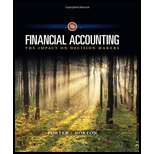
Concept explainers
Concept Introduction:
Deferred tax arises out of the temporary difference between the tax income and accounting income.
When the difference results in reducing the tax payments in the future years, this generates
Permanent and temporary differences:
Permanent differences between the accounting income and tax income arise when the difference is not reversed in future years.For example taxes exempt from income tax which are included in accounting income result in permanent difference.
Temporary difference arises when there are only timing differences and the impact of which will be reversed in future years.
The amount of taxes by the company in the three given years
b
Concept Introduction:
Deferred tax Asset and liabilities:
Deferred tax arises out of the temporary difference between the tax income and accounting income.
When the difference results in reducing the tax payments in the future years, this generates deferred tax assets. However, if the differences result in increasing the future tax payments, deferred tax liability is generated.
Permanent and temporary differences:
Permanent differences between the accounting income and tax income arise when the difference is not reversed in future years.For example, taxes exempt from income tax which are included in accounting income result in permanent difference.
Temporary difference arises when there are only timing differences and the impact of which will be reversed in future years.
The balance in deferred tax at the end of each year.
Want to see the full answer?
Check out a sample textbook solution
Chapter 10 Solutions
EBK FINANCIAL ACCOUNTING: THE IMPACT ON
- Month Monthly Product Demand 2021-01-01 207.55 2021-02-01 208.25 2021-03-01 209.33 2021-04-01 210.11 2021-05-01 213.78 2021-06-01 225.12 2021-07-01 227.19 2021-08-01 218.92 2021-09-01 213.25 2021-10-01 210.75 2021-11-01 215.97 2021-12-01 223.97 2022-01-01 220.54 2022-02-01 213.47 2022-03-01 218.48 2022-04-01 222.07 2022-05-01 222.85 2022-06-01 236.38 2022-07-01 248.60 2022-08-01 234.45 2022-09-01 217.32 2022-10-01 222.56 2022-11-01 237.77 2022-12-01 245.59 2023-01-01 237.75 2023-02-01 213.70 2023-03-01 238.18 2023-04-01 244.78 2023-05-01 233.42 2023-06-01 241.35 2023-07-01 267.98 2023-08-01 249.97 2023-09-01 220.58 2023-10-01 233.12 2023-11-01 240.90 2023-12-01 268.61 2024-01-01 250.80 2024-02-01 225.31 2024-03-01 247.32 2024-04-01 248.50 2024-05-01 237.35 2024-06-01 258.62 2024-07-01 284.45 2024-08-01 256.21 2024-09-01 225.73 2024-10-01 234.07 2024-11-01 263.70 2024-12-01 286.03 Please…arrow_forwardAccounting 12 May I please have a brief summary highlighting one unique feature of the app, recommending it to Sadie—who wants to use some apps for her dog grooming salon to schedule grooming appointments? Thank you so much,arrow_forwardGiven solution for General accounting question not use aiarrow_forward
- Kindly help me with this General accounting questions not use chart gpt please fast given solutionarrow_forwardPlease given correct answer for General accounting question I need step by step explanationarrow_forwardQuiksilver Company sold 4,480 units in October at a price of $63 per unit. The variable cost is $51 per unit. Calculate the total contribution margin. A. $62,060 B. $73,080 C. $56,000 D. $99,750 E. $ 53,760 helparrow_forward
 Financial Accounting: The Impact on Decision Make...AccountingISBN:9781305654174Author:Gary A. Porter, Curtis L. NortonPublisher:Cengage Learning
Financial Accounting: The Impact on Decision Make...AccountingISBN:9781305654174Author:Gary A. Porter, Curtis L. NortonPublisher:Cengage Learning Excel Applications for Accounting PrinciplesAccountingISBN:9781111581565Author:Gaylord N. SmithPublisher:Cengage Learning
Excel Applications for Accounting PrinciplesAccountingISBN:9781111581565Author:Gaylord N. SmithPublisher:Cengage Learning Intermediate Accounting: Reporting And AnalysisAccountingISBN:9781337788281Author:James M. Wahlen, Jefferson P. Jones, Donald PagachPublisher:Cengage Learning
Intermediate Accounting: Reporting And AnalysisAccountingISBN:9781337788281Author:James M. Wahlen, Jefferson P. Jones, Donald PagachPublisher:Cengage Learning





